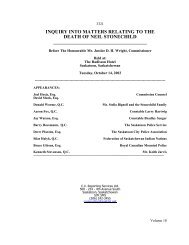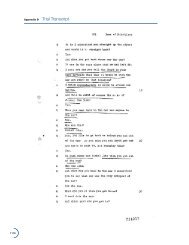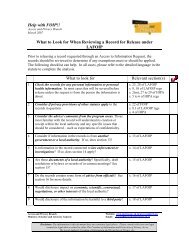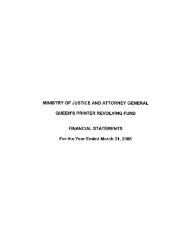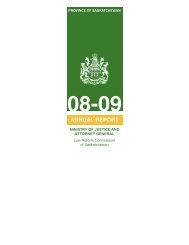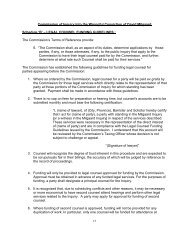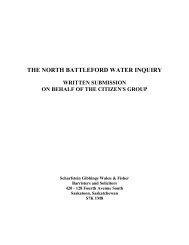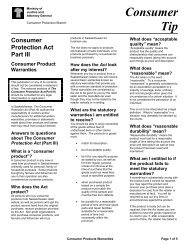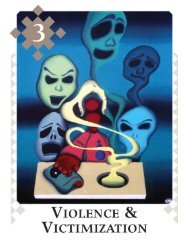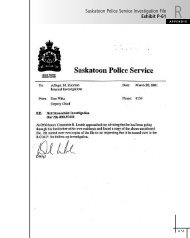Appendix K Memorandum of Law - s. 9(2) of the Canada Evidence Act
Appendix K Memorandum of Law - s. 9(2) of the Canada Evidence Act
Appendix K Memorandum of Law - s. 9(2) of the Canada Evidence Act
You also want an ePaper? Increase the reach of your titles
YUMPU automatically turns print PDFs into web optimized ePapers that Google loves.
<strong>Appendix</strong> K <strong>Memorandum</strong> <strong>of</strong> <strong>Law</strong><br />
In my view, <strong>the</strong> Judge was in error in ruling that <strong>the</strong> witness could be cross-examined by <strong>the</strong> Crown as an<br />
adverse witness. At <strong>the</strong> stage when <strong>the</strong> application was made initially to cross-examine on <strong>the</strong> basis <strong>of</strong><br />
s. 9(2), <strong>the</strong> evidence <strong>of</strong> <strong>the</strong> witness can be summarized as follows:<br />
(1) That McInroy and Jordan had returned to her house at approximately <strong>the</strong> time as Jordan said <strong>the</strong>y did.<br />
(2) That she had a conversation in <strong>the</strong> kitchen with McInroy.<br />
(3) That she had gone for a ride with McInroy and he had instructed her to throw a paper bag out <strong>of</strong> <strong>the</strong><br />
window.<br />
There could be no reason for <strong>the</strong> Crown to challenge <strong>the</strong>se three items <strong>of</strong> evidence. The Crown’s purported<br />
purpose in using <strong>the</strong> previous statement was on <strong>the</strong> issue <strong>of</strong> her credibility. But credibility was not in<br />
issue. Mrs. St. Germaine had testified to nothing damaging to <strong>the</strong> Crown’s case. She had simply<br />
disclaimed any present relevant testimonial knowledge <strong>of</strong> <strong>the</strong> conversation with McInroy. In such<br />
a case a prior inconsistent statement <strong>of</strong> facts favourable to <strong>the</strong> proponent <strong>of</strong> <strong>the</strong> witness may not be used to<br />
impeach her.<br />
With great respect, I am not in agreement that <strong>the</strong>re was error in this case on <strong>the</strong> part <strong>of</strong> <strong>the</strong> trial Judge. The basis<br />
for <strong>the</strong> Court’s conclusion that <strong>the</strong>re was error is stated in <strong>the</strong> first sentence <strong>of</strong> <strong>the</strong> passage quoted “in ruling that<br />
<strong>the</strong> witness could be cross-examined by <strong>the</strong> Crown as an adverse witness’. Following this statement reference<br />
is made to <strong>the</strong> evidence given by Mrs. St. Germaine prior to questions and answers leading to <strong>the</strong> Crown’s<br />
application. Her earlier evidence was not adverse to <strong>the</strong> Crown’s position. The inference is that this prevents her<br />
from being regarded as an adverse witness.<br />
Section 9(2) is not concerned with <strong>the</strong> cross-examination <strong>of</strong> an adverse witness. That subsection confers a<br />
discretion on a trial Judge where <strong>the</strong> party producing a witness alleges that <strong>the</strong> witness has made, at ano<strong>the</strong>r<br />
time, a written statement inconsistent with <strong>the</strong> evidence being given at <strong>the</strong> trial. The discretion is to permit,<br />
without pro<strong>of</strong> that <strong>the</strong> witness is adverse, cross-examination as to <strong>the</strong> statement.<br />
The task <strong>of</strong> <strong>the</strong> trial Judge was to determine whe<strong>the</strong>r Mrs. St. Germaine’s testimony was inconsistent with her<br />
statement to <strong>the</strong> police. In my opinion, he was properly entitled to conclude that it was. At trial Mrs. St. Germaine<br />
swore that she could not recall any part <strong>of</strong> <strong>the</strong> conversation with McInroy in <strong>the</strong> kitchen <strong>of</strong> her house on <strong>the</strong> night<br />
<strong>of</strong> <strong>the</strong> killing, although only some seven months earlier she had given to <strong>the</strong> police, in her written statement, <strong>the</strong><br />
details <strong>of</strong> that conversation, including McInroy’s admission that he was <strong>the</strong> murderer. If her statement at trial as<br />
to her recollection was true, inconsistency would not arise, but <strong>the</strong> trial Judge saw Mrs. St. Germaine<br />
and heard her evidence on <strong>the</strong> voir dire. It was quite open to him to conclude that she was lying<br />
about her recollection and to form his own conclusions as to why she was refusing to testify as to her<br />
true recollection <strong>of</strong> a conversation, and what was contained in her written statement, i.e., a detailed<br />
recollection <strong>of</strong> it.<br />
…<br />
The granting <strong>of</strong> <strong>the</strong> Crown’s application was a matter for <strong>the</strong> sole direction <strong>of</strong> <strong>the</strong> trial Judge and, in<br />
my view, he had adequate grounds for exercising that discretion as he did. Having granted <strong>the</strong> application<br />
<strong>the</strong> Crown was entitled to cross-examine Mrs. St. Germaine before <strong>the</strong> jury. The trial Judge was careful to explain,<br />
in <strong>the</strong> passage I have already quoted, <strong>the</strong> limited extent to which that cross-examination might be considered by<br />
<strong>the</strong> jury. [Emphasis added].<br />
McInroy holds that where a witness claims that he or she has no recollection <strong>of</strong> <strong>the</strong> matters contained in a<br />
prior statement, it is within <strong>the</strong> sole discretion <strong>of</strong> <strong>the</strong> trial Judge to find that <strong>the</strong> witness is lying about his or<br />
her lack <strong>of</strong> recollection and conclude that <strong>the</strong>re is an ‘inconsistency’ between <strong>the</strong> witness’ testimony and<br />
<strong>the</strong> prior statement. 81 That is, an ‘inconsistency’ will arise under s. 9(2) <strong>of</strong> <strong>the</strong> CEA even when a witness<br />
81 See also <strong>the</strong> excerpt from Witnesses, supra note 15, containing an explanation <strong>of</strong> <strong>the</strong> McInroy case and comments<br />
on meaning <strong>of</strong> <strong>the</strong> term ‘inconsistency’ .<br />
2600



